Technical SEO is a critical component of any successful online marketing strategy. If you’ve ever wondered, “What is technical SEO?” or searched for a comprehensive “technical SEO guide,” you’ve come to the right place.
In this ultimate guide, we’ll dive deep into the world of technical SEO, covering everything from the basics to advanced techniques. By the end, you’ll have a complete technical SEO checklist and a solid understanding of technical SEO best practices.
In today’s digital landscape, having a great website with high-quality content is not enough.
You must ensure your website is built on a solid technical foundation to rank higher in search engine results and attract more visitors.
That’s where technical SEO comes in. It involves optimizing your website’s structure, performance, and code to make it easier for search engines to crawl, index, and rank your content.
This guide will cover essential aspects of technical SEO, such as crawling and indexing, rendering issues, site speed, duplicate content, broken pages, mobile-friendliness, structured data, and security.
We’ll also debunk common myths and misconceptions about technical SEO and provide actionable tips and tools to help you stay ahead of the competition.
So, whether you’re a seasoned digital marketer or a small business owner looking to improve your online presence, this guide will be your go-to resource for technical SEO.
TL;DR: Technical SEO is the process of optimizing your website’s structure, performance, and code to make it more accessible and user-friendly for both search engines and users. It involves improving crawling and indexing, fixing rendering issues, enhancing site speed, avoiding duplicate content, repairing broken pages, ensuring mobile-friendliness, implementing structured data, and maintaining website security. Following this guide and adopting technical SEO best practices can significantly improve your website’s search engine rankings and drive more organic traffic.
As SEO experts, we can attest to the importance of mastering technical SEO.
It’s a crucial aspect of SEO (or Search Engine Optimization) that can make or break your website’s visibility and performance.
So let’s dive into technical SEO and discover how to optimize your website for search engines and users alike.
Table of Contents
- What is technical SEO?
- Why should you improve your technical SEO?
- What are technical SEO tools?
- How to do a technical SEO analysis?
- Technical SEO Checklist
- Crawling and indexing
- Create an SEO-friendly URL structure
- Create an internal link structure
- Robots.txt
- Meta tags
- Canonical tag
- Hreflang tag
- Redirects
- 404 page
- XML sitemap
- How to fix rendering issues?
- How to improve your site speed?
- How to avoid duplicate content?
- How to find and fix broken pages?
- How to make your website mobile-friendly?
- Structured data
- Website Security
- Final Thoughts
- Frequently Asked Questions about Technical SEO
- What is technical SEO, and how does it differ from on-page and off-page SEO?
- How can technical SEO improve my website's ranking on search engine result pages?
- What are the essential components of technical SEO, and how do they affect my website's performance?
- How can I conduct a technical SEO audit on my website, and what are the benefits of doing so?
- What are websites' most common technical SEO issues, and how can they be fixed?
- How can website speed impact technical SEO, and how can I optimize it?
- How can I optimize my website's structure and navigation for technical SEO?
- What is schema markup, and how can it improve my website's visibility in search results?
- How can I ensure my website is mobile-friendly and optimized for technical SEO?
- How do website security and HTTPS encryption impact technical SEO, and what are the best practices?
- How can I optimize my website's images and media for technical SEO purposes?
- What is canonicalization, and how can it be used for technical SEO purposes?
- How can I optimize my website's XML sitemap and robots.txt file for technical SEO?
- What is hreflang, and how can it be used to optimize my website for multilingual SEO?
- What is crawl budget, and how can I optimize it for technical SEO purposes?
- How do meta tags and descriptions impact technical SEO, and what are the best practices?
- How can I optimize my website's internal linking structure for technical SEO purposes?
- What are the best practices for optimizing URL structure for technical SEO purposes?
- How can I use Google Search Console to monitor and improve my website's technical SEO performance?
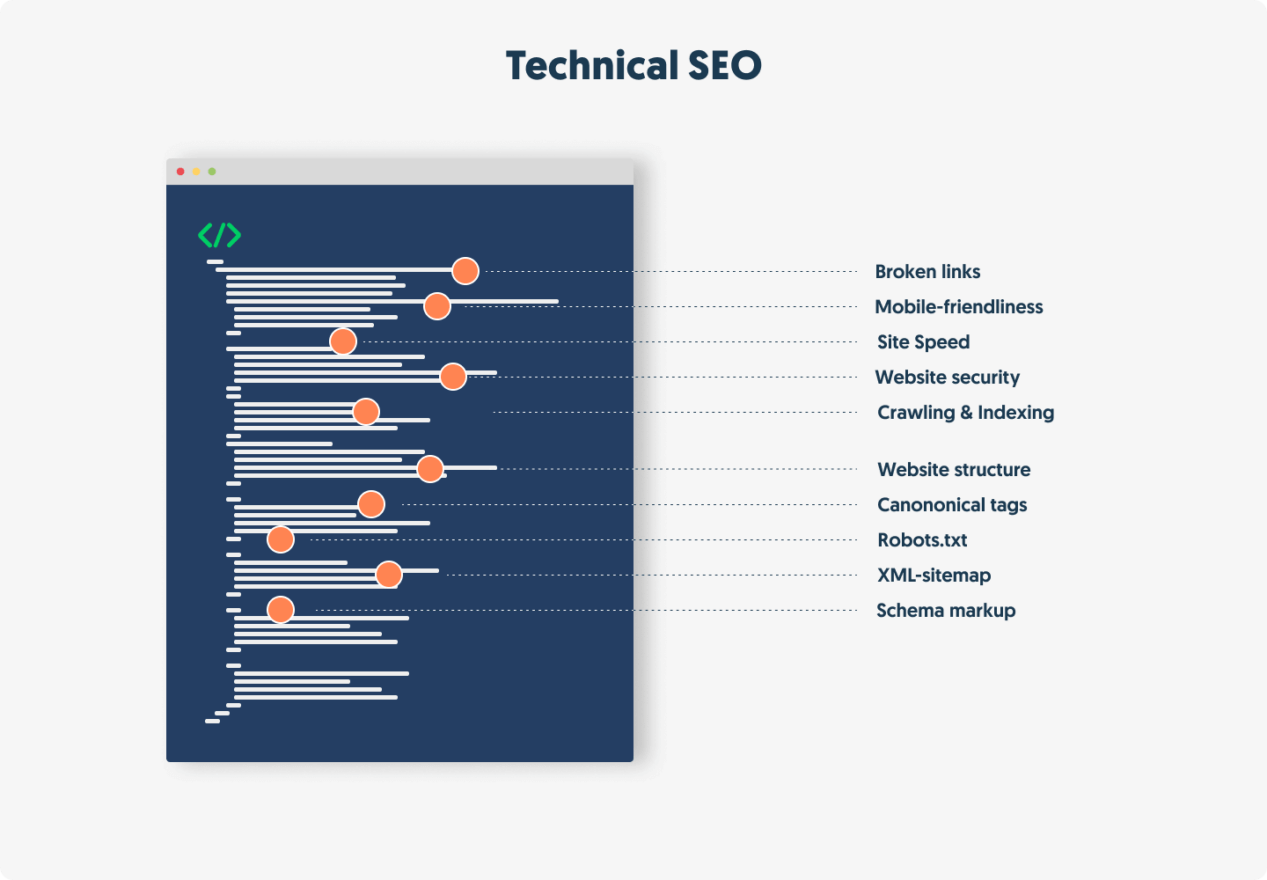
What is technical SEO?
Technical SEO refers to optimizing a website’s technical aspects to make it more accessible, user-friendly, and search engine-friendly. It encompasses various techniques and best practices that aim to improve a website’s structure, performance, and code, ensuring that search engines can easily crawl, index, and rank the site’s content.
Unlike on-page and off-page SEO, which focus on content and backlinks, technical SEO targets the website’s underlying infrastructure and code.
You can have the best-looking website in the world, and top-notch content, but poor technical SEO can still hinder your chances of ranking.
Ultimately, Google and other search engines must efficiently locate, crawl, render, and index your website’s pages.
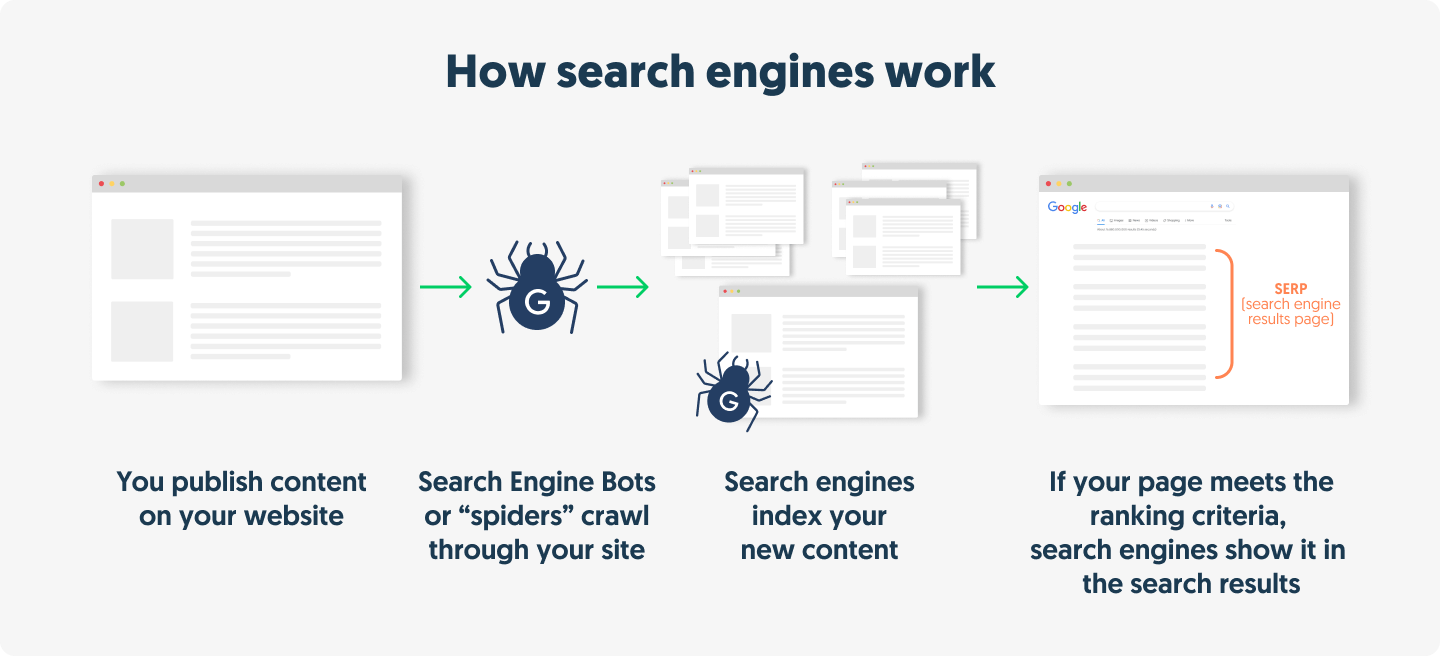
Finding, crawling, rendering, and indexing pages is essential for search engines. However, that’s merely the tip of the iceberg. Even if Google manages to index all of your website’s content, it doesn’t mean your work is complete.
For your site to be fully optimized for technical SEO, your pages must be secure, mobile-optimized, free of duplicate content, quick to load, and meet numerous other technical optimization criteria.
That is why some of the key components of technical SEO include:
- Crawling and indexing
- Site speed optimization
- Mobile-friendliness
- Duplicate content management
- Broken pages and links repair
- Structured data implementation
- Website security
That said, your technical SEO doesn’t have to be flawless to rank. It’s not a requirement.
But by making it as easy as possible for Google to access your content, you significantly increase your chances of ranking higher.
Why should you improve your technical SEO?
Improving your technical SEO is crucial for several reasons:
- Better search engine visibility: A well-optimized website allows search engines to crawl and index your content more efficiently, leading to higher rankings in search engine results pages (SERPs) and increased visibility.
- Enhanced user experience: Technical SEO improvements, such as faster page load times and mobile-friendliness, contribute to a better user experience, encouraging users to spend more time on your site and engage with your content.
- Higher conversion rates: By offering an improved user experience, you increase the likelihood of visitors converting into customers, subscribers, or leads.
- Competitive advantage: In competitive niches, having a technically optimized website can give you an edge over your competitors, enabling you to rank higher and attract more organic traffic.
- Future-proofing your website: Regularly auditing and updating your website’s technical aspects ensures that it stays up-to-date with the latest search engine algorithms and best practices, preventing potential ranking drops and security issues.
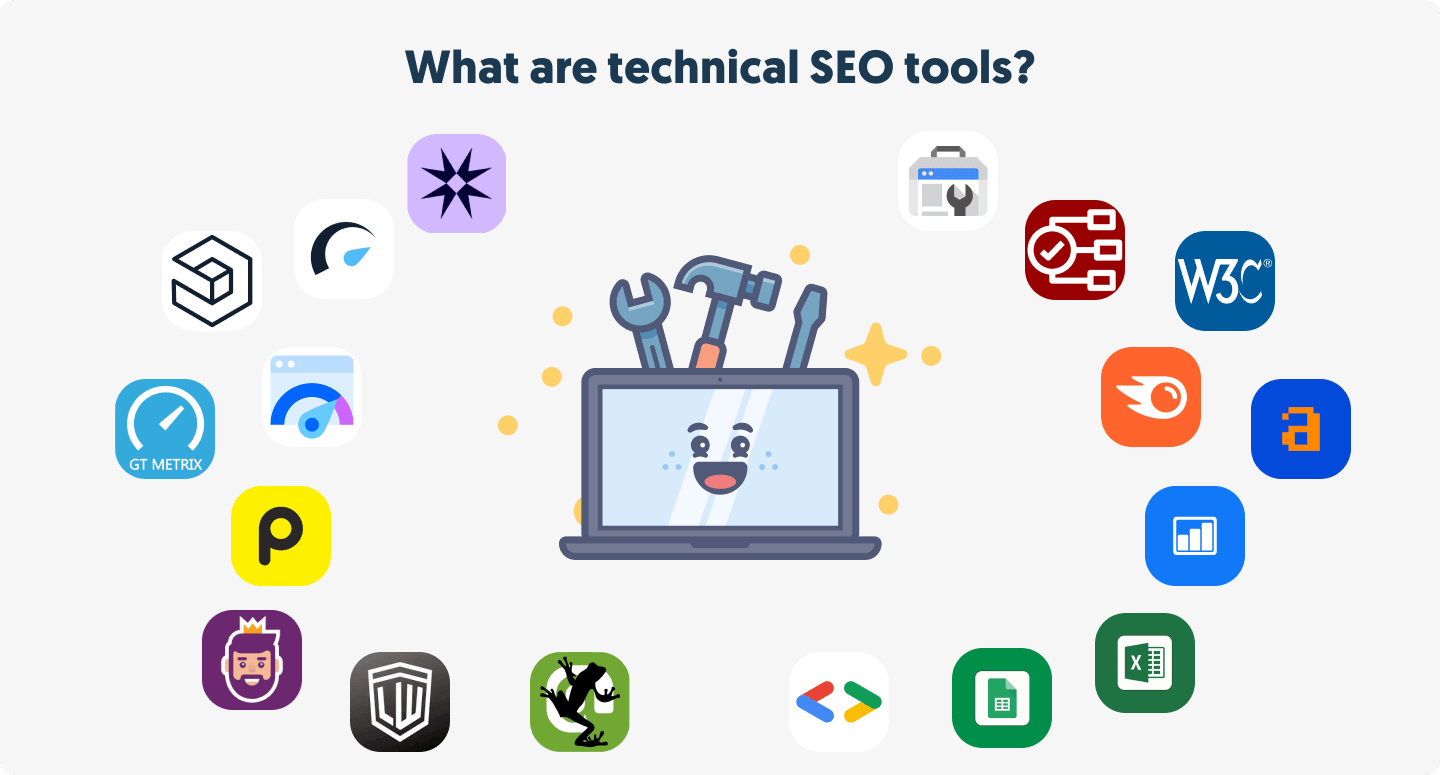
What are technical SEO tools?
Technical SEO tools are software applications and platforms designed to help you analyze, monitor, and optimize your website’s technical aspects. These tools can provide valuable insights into your website’s performance, identify issues, and suggest actionable improvements. Here’s a list of technical SEO tools that can assist you in optimizing your website:
- Webcrawler: Tools like Screaming Frog SEO Spider or Lumar (formerly DeepCrawl) allow you to crawl your website, identifying technical issues such as broken links, duplicate content, and missing meta tags.
- Google Search Console: A free tool provided by Google that offers insights into your website’s search performance, indexability, and technical issues.
- Logfile analysis tool: Software like Logz.io, or Screaming Frog Log File Analyzer can help you analyze your server log files, offering insights into search engine crawl behavior and identifying potential crawl issues.
- Website page speed tools: Tools like Google PageSpeed Insights, GTmetrix, WebPageTest, and Pingdom Tools help you analyze your website’s load times and provide suggestions for improving site speed.
- SEO alert tools: Platforms like ContentKing or Little Warden monitor your website for SEO-related changes and issues, sending you alerts so you can take timely action.
- Schema Validator or Structured Data testers: Use Google’s Structured Data Testing Tool, Schema.org Validator, or Yandex Structured Data Validator to check the implementation of structured data on your site, which can enhance your search engine visibility and click-through rates.
- W3C Validator: This tool checks your website’s HTML and CSS code for compliance with web standards, ensuring cross-browser compatibility and proper rendering.
- Ahrefs/SEMRush/SE Ranking Site Audit: Comprehensive website auditing tools, like the Ahrefs site audit, Semrush site audit, and the SE Ranking Site Audit scan your site for technical SEO issues and provide actionable recommendations to improve your website’s performance and search engine visibility.
- Excel: Microsoft Excel or similar spreadsheet applications like Google Sheets can be used to organize, analyze, and visualize your website’s technical SEO data, helping you identify trends and areas for improvement.
Combining these technical SEO tools will help you gain valuable insights into your website’s performance, uncover issues, and implement the necessary optimizations to improve your search engine rankings and overall online presence.
How to do a technical SEO analysis?
Conducting a technical SEO analysis involves evaluating your website’s technical aspects to identify issues and opportunities for improvement. Here’s a step-by-step guide to performing a technical SEO analysis:
- Crawl your website: Use a crawling tool like Screaming Frog SEO Spider or Ahrefs, Semrush, or SE Ranking Site Audit, to scan your site for technical issues, such as broken links, duplicate content, and missing meta tags.
- Review crawling and indexing: Check Google Search Console to ensure your site is crawled and indexed properly by search engines. Look for any crawl errors, sitemap issues, or blocked resources.
- Analyze site speed: Use PageSpeed Insights or another speed testing tool to evaluate your website’s load times and identify areas for improvement.
- Check mobile-friendliness: Use Google’s Mobile-Friendly Test tool to assess your site’s mobile-friendliness and ensure a seamless experience for users on mobile devices.
- Examine duplicate content: Use a tool like Siteliner or Copyscape to scan your site for duplicate content, which can negatively impact your search engine rankings.
- Evaluate site structure and internal linking: Review your site’s URL structure, navigation, and internal linking to ensure it’s logical, easy to navigate, and search engine-friendly.
- Inspect structured data and rich snippets: Use Google’s Structured Data Testing Tool or Schema.org Validator to check the implementation of structured data on your site, which can enhance your search engine visibility and click-through rates.
- Assess website security: Verify that your site uses HTTPS, has a valid SSL certificate, and follows other security best practices to protect user data and maintain search engine trust.
- Review your site’s meta tags: Ensure your website has unique, descriptive title tags and meta descriptions for each page, which help search engines understand the content and encourage users to click through from search results.
After completing your technical SEO analysis, prioritize the identified issues and work on implementing the necessary fixes and optimizations. Regularly monitoring and updating your site’s technical aspects will help you maintain a solid online presence and stay ahead of the competition.

Technical SEO Checklist
Now that you understand the basics, let’s help you with a comprehensive technical SEO checklist to help you optimize your website for search engines effectively. By following these best practices, you can ensure that your website’s technical aspects are in good shape, allowing search engines to crawl, index, and rank your content efficiently.
Crawling and indexing
The first step in optimizing your website for search engines is to ensure it’s easily crawlable and indexable. This involves creating a logical site structure, implementing SEO-friendly URLs, and using essential HTML tags. The following list covers the crucial aspects of crawling and indexing that you should address to improve your website’s technical SEO.
Create an SEO-friendly URL structure
An SEO-friendly URL structure is essential for both search engines and users. It helps search engines understand your site’s hierarchy and enables users to navigate your site more easily.
In our opinion, it all begins with your site’s structure.
Why?
Many crawling and indexing issues happen because people did not design their site structure properly when creating their websites. So if you get this step right, you don’t need to worry as much about Google indexing all of your site’s pages.
On top of that, your site structure influences everything else you do to optimize your site… from URLs to your sitemap to using robots.txt to block search engines from certain pages.
To create an SEO-friendly URL structure:
- Use lowercase letters, and hyphens instead of spaces, and avoid special characters.
- Include target keywords in the URL.
- Keep URLs short, descriptive, and relevant to the content.
Create an internal link structure
A well-organized internal link structure helps search engines crawl and index your website more efficiently. It also improves user experience by making it easier for visitors to navigate your site. To create an effective internal link structure:
- Use descriptive anchor text that accurately reflects the linked content.
- Link to relevant pages within your site to provide additional context and value.
- Avoid using too many links on a single page, as it can dilute link equity.
Robots.txt
The robots.txt file provides instructions to search engines about how to crawl and index your site. To optimize your robots.txt file:
- Ensure that it’s accessible at the root directory of your website (e.g., example.com/robots.txt).
- Use the “Allow” and “Disallow” directives to control which parts of your site search engines can crawl.
- Test your robots.txt file using Google Search Console to ensure it functions correctly.
Meta tags
Meta tags provide information about your web pages to search engines. Some essential meta tags for technical SEO include:
- Title tag: A unique, descriptive title for each page that includes target keywords.
- Meta description: A summary of your page’s content that encourages users to click on your search result.
- Robots meta tag: Controls how search engines crawl and index specific pages on your site.
Canonical tag
The canonical tag helps search engines identify the preferred version of a web page when duplicate content exists. To use the canonical tag effectively:
- Add a self-referencing canonical tag to each unique page on your site.
- For duplicate or similar content, point the canonical tag to the preferred version of the page.
Hreflang tag
The hreflang tag tells search engines which language and regional versions of a page to display to users. To implement hreflang tags:
- Use the hreflang attribute on each language or regional version of a page.
- Ensure that each version links to all other versions, including itself.
Redirects
Redirects send users and search engines from one URL to another when a page has been moved or deleted. To use redirects effectively:
- Use 301 redirects for permanent changes and 302 redirects for temporary changes.
- Ensure that all redirects point to relevant, live pages to avoid creating redirect chains or loops.
- Regularly audit your redirects to identify and fix any broken or unnecessary redirects.
404 page
A custom 404 page helps users and search engines navigate your site when they encounter a broken or missing page. To create an effective 404 page:
- Design a user-friendly 404 page with clear messaging and a link to your homepage or a relevant site section.
- Monitor your site for 404 errors using tools like Google Search Console and fix broken links as needed.
- Implement a 410 status code for permanently removed pages to inform search engines that the content is intentionally unavailable.
XML sitemap
An XML sitemap is a roadmap of your website that helps search engines discover and index your content. To create and optimize an XML sitemap:
- Include all essential pages of your site, such as blog posts, product pages, and category pages.
- Update your XML sitemap whenever you add or remove content from your site.
- Submit your XML sitemap to search engines like Google and Bing using their respective webmaster tools.
How to fix rendering issues?
Fixing rendering issues is crucial for maintaining a positive user experience and ensuring search engines can accurately index your content. Common misconceptions might lead you to believe that rendering issues are only about visual presentation but can also affect crawlability and overall SEO performance.
View Rendered Source, Diffchecker, and Google Search Console’s URL Inspection Tool are three helpful tools for identifying and fixing rendering issues.
View Rendered Source Chrome Extension
Our favorite, the “View Rendered Source” Chrome extension, is a valuable tool for analyzing the rendered HTML of a webpage. It allows you to view the original HTML source code, the rendered HTML after JavaScript execution, and the differences between the two.
To use the “View Rendered Source” extension:
- Visit the Chrome Web Store
- Click “Add to Chrome” to install the extension.
- Once installed, navigate to the webpage you want to analyze.
- Click the “View Rendered Source” icon in your browser’s toolbar or right-click on the page and select “View Rendered Source” from the context menu.
- The extension will open a new window displaying the original HTML, the rendered HTML, and the differences between the two.
Diffchecker:
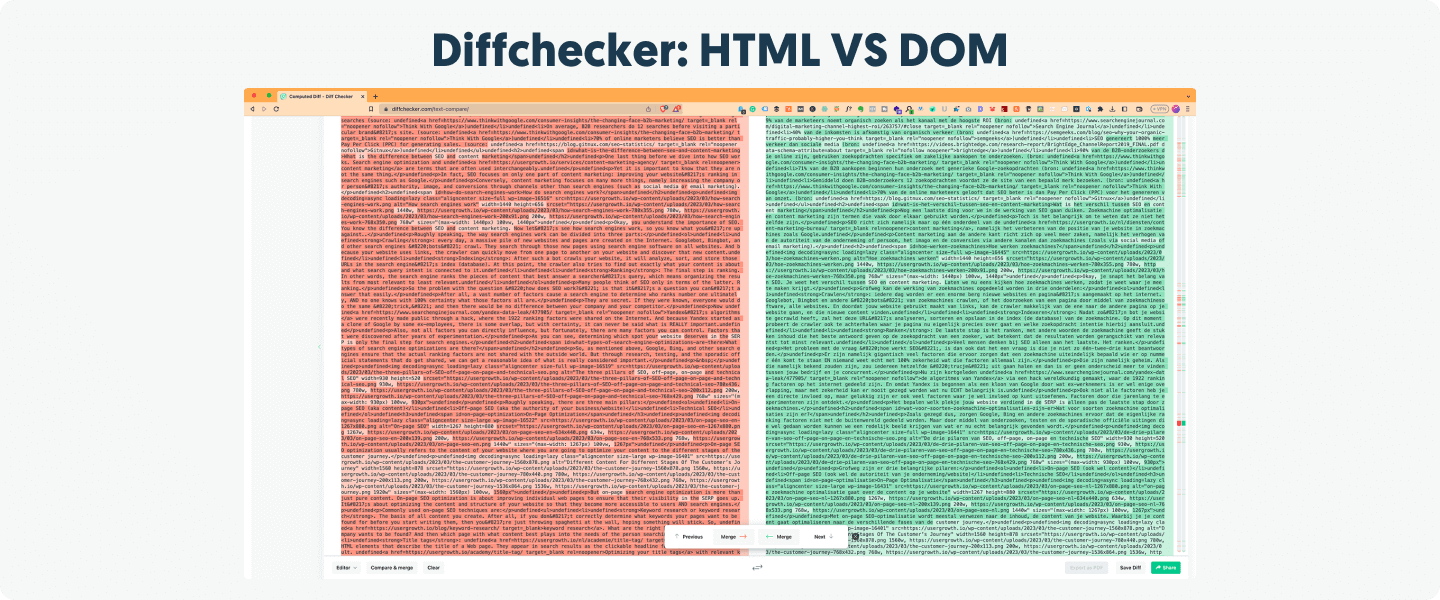
Diffchecker allows you to copy and paste original and modified versions of your text or source code and show where the difference is. To use Diffchecker:
- Visit https://www.diffchecker.com/
- Input the original version of your code in the left textbox and the modified version in the right textbox.
- Click “Find Difference” to identify any discrepancies between the two versions of your code.
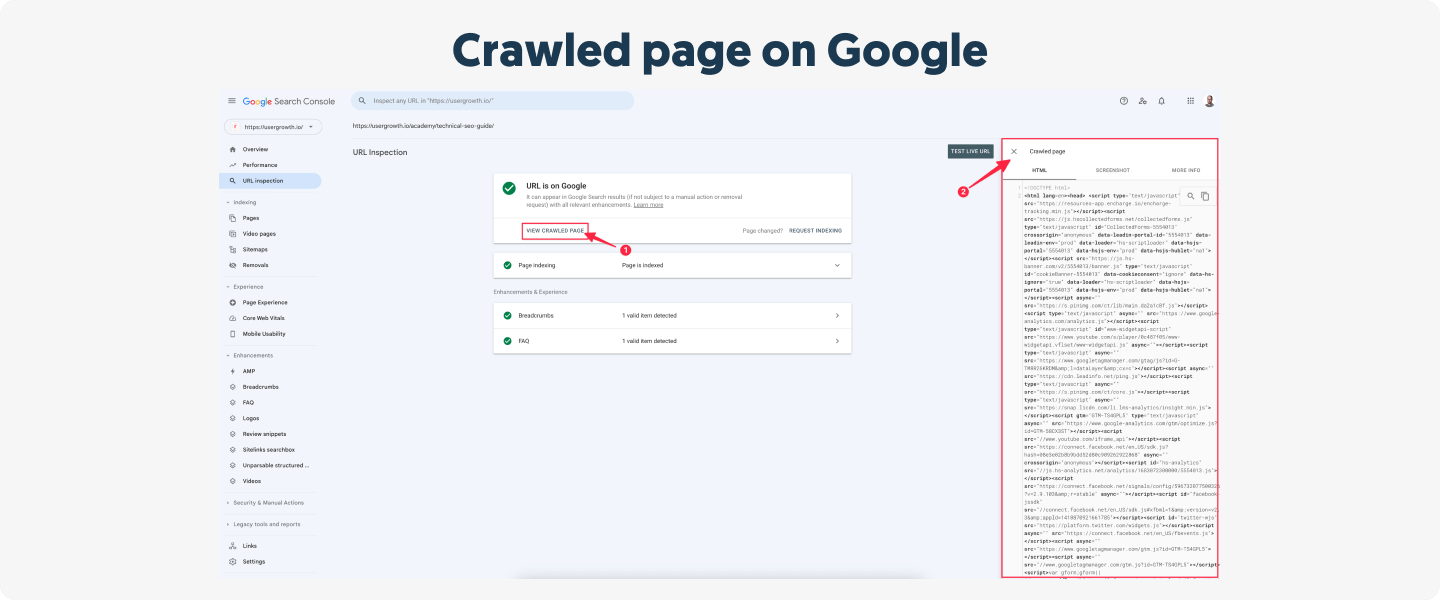
Google Search Console’s URL Inspection Tool:
- Log in to your Google Search Console account.
- Navigate to the URL Inspection Tool.
- Enter the URL of the page you want to inspect.
- Click “Test Live URL” to analyze the live version of the page.
- Review the results and address any rendering issues identified.
- You can watch how Google views the page by clicking on “View Crawled Page” (1) and seeing the results (2).
How to improve your site speed?
Improving site speed is crucial for user experience and SEO, especially with the introduction of Core Web Vitals and the Page Experience update. Google PageSpeed Insights, GTmetrix, and WebPageTest are three valuable tools for analyzing and improving site speed.
Google PageSpeed Insights:
- Visit https://developers.google.com/speed/pagespeed/insights/
- Enter your website’s URL and click “Analyze”.
- Review the results and follow the recommendations to improve your site speed.
GTmetrix:
- Visit https://gtmetrix.com/
- Enter your website’s URL and click “Test your site”.
- Review the results and implement the suggested optimizations to improve site speed.
WebPageTest:
- Visit https://www.webpagetest.org/
- Enter your website’s URL, choose a test location, and click “Start Test”.
- Review the results and address any identified performance issues.
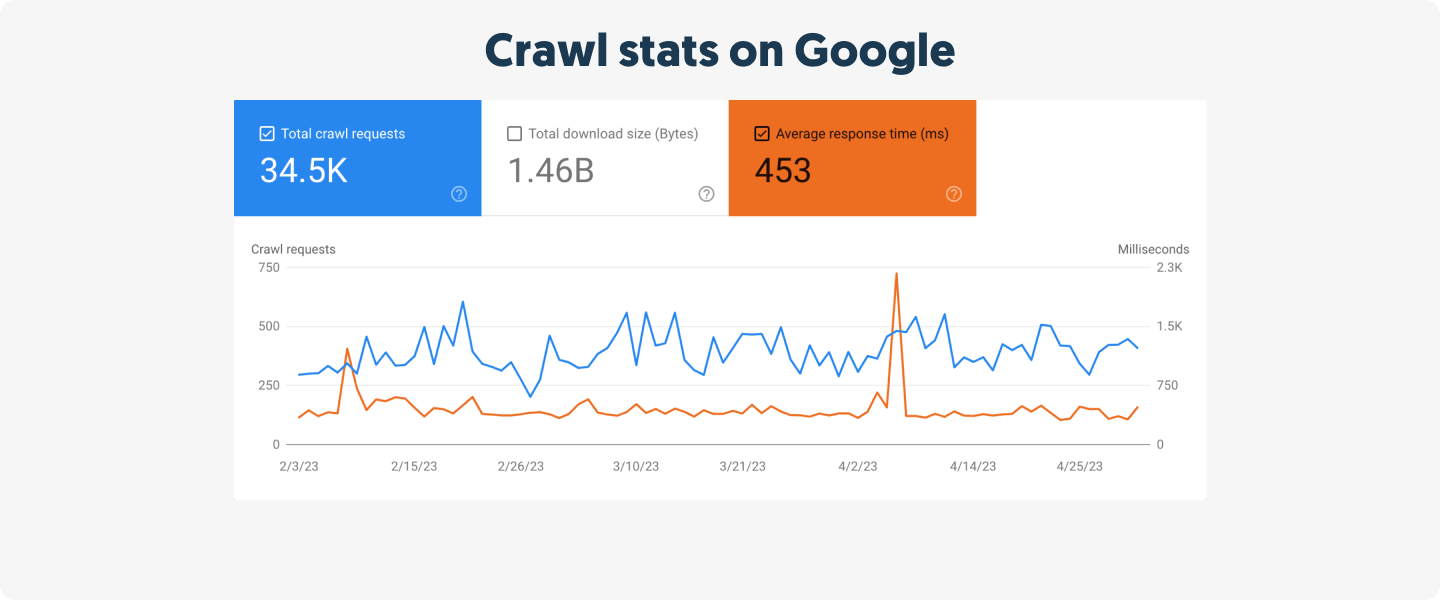
If you want to view what your current crawlbudget is, head over to Search Console > Settings > Crawl Stats. This will show you the Crawl Stats report.
How to avoid duplicate content?
Avoiding duplicate content is essential for maintaining your website’s authority and search engine rankings. One useful tool for identifying duplicate content is Screaming Frog, which now includes a “Near Duplicates” tab. This tab displays the content percentage matching other pages on your website, allowing you to identify and address duplicate content issues quickly.
How to find and fix broken pages?
Broken pages can evoke negative emotions in your visitors and damage your website’s credibility. Using tools like Google Search Console can help you find and fix broken pages efficiently.
- Log in to your Google Search Console account.
- Navigate to the “Coverage” report.
- Review the list of pages with errors and address any issues to fix broken pages.
How to make your website mobile-friendly?
With most web traffic now originating from mobile devices, making your website mobile-friendly is essential. The mobile-first index further emphasizes the importance of optimizing for mobile users. Designing and building with a mobile-first approach ensures your website performs well on all devices.
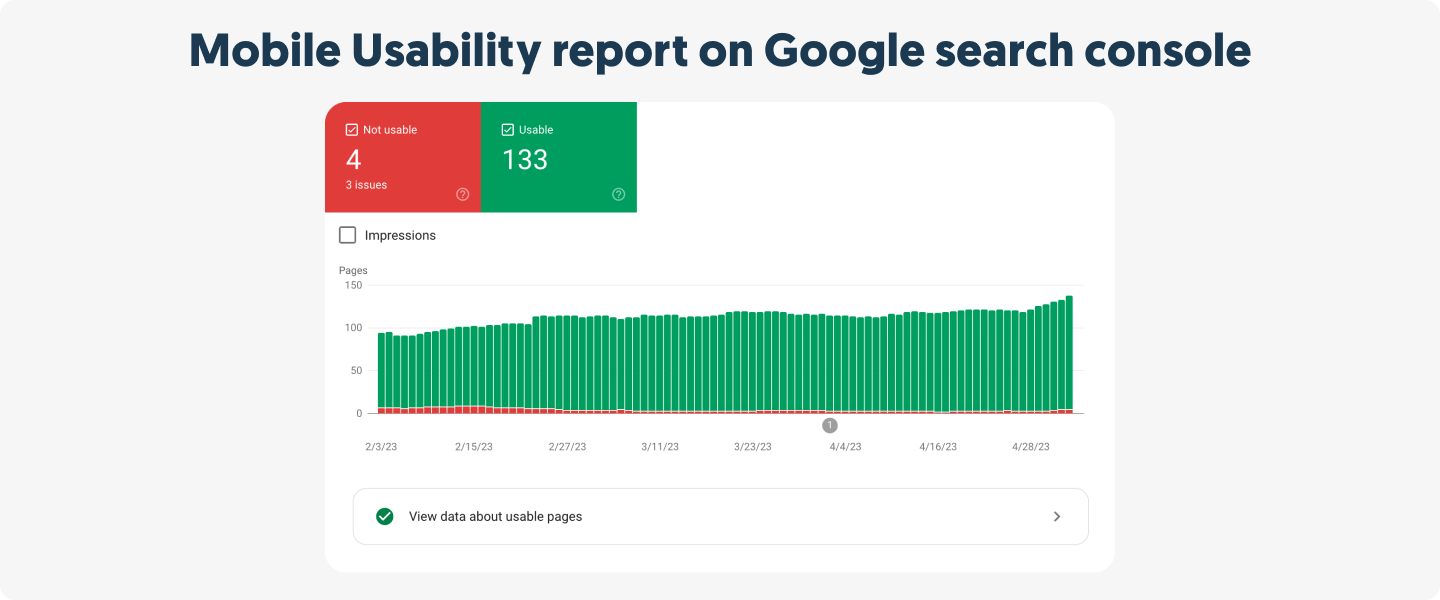
Structured data
Structured data is an initiative by Google, Bing, Yahoo, and Yandex that helps search engines better understand and present your content. Implementing structured data can improve your website’s search engine visibility and click-through rates. You can check and validate your structured data using Google’s Structured Data Testing Tool and Schema.org Validator.
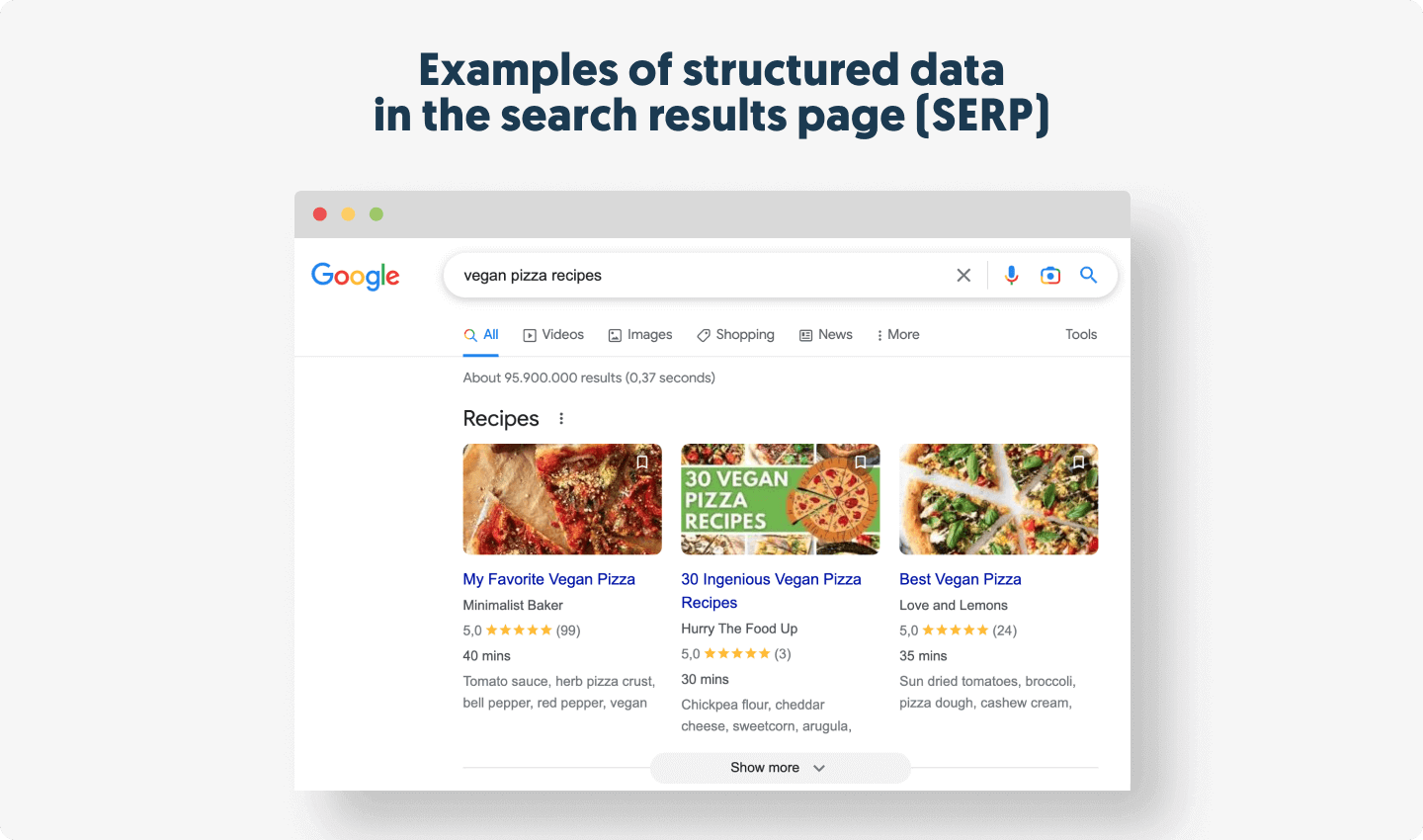
Google’s Structured Data Testing Tool:
- Visit https://search.google.com/structured-data/testing-tool/
- Enter your website’s URL or paste your HTML code.
- Click “Run Test” and review the results to ensure your structured data is correctly implemented.
Schema.org Validator:
- Visit https://validator.schema.org/
- Enter your website’s URL or paste your HTML code.
- Click “Validate” and review the results to ensure your structured data is correctly implemented.
By following the steps and utilizing the tools mentioned in these sections, you’ll be able to address common technical SEO issues, improve your website’s performance, and ultimately enhance its visibility in search engine results. Remember to continuously monitor your website for any issues and stay up-to-date with the latest SEO best practices to maintain a strong online presence.
Website Security
Website security is a crucial aspect of technical SEO, as it protects your website from potential hacking attempts and helps maintain your search engine rankings. A secure website fosters trust among users and is more likely to rank higher in search engine results.
SSL Certificates
One of the primary security measures you should implement on your website is an SSL (Secure Sockets Layer) certificate. SSL certificates encrypt data transferred between the user’s browser and your website, ensuring sensitive information like personal data and payment details remain secure. Search engines like Google prioritize websites with SSL certificates, and users often feel more comfortable interacting with a site displaying the “HTTPS” and padlock symbol in the address bar.
To add an SSL certificate to your website:
- Purchase an SSL certificate from a trusted Certificate Authority (CA) or check if your hosting provider offers a free SSL certificate.
- Install the SSL certificate on your web server following the instructions provided by the CA or your hosting provider.
- Update all internal and external links to use HTTPS, and set up 301 redirects from HTTP to HTTPS.
- Update your website’s sitemap and robots.txt file to use HTTPS URLs.
- Inform Google Search Console of the change to HTTPS by adding a new property for your HTTPS website and resubmitting your sitemap.
Preventing Hacking Attempts
A hacked website can quickly lose its search engine rankings, as search engines may penalize websites with compromised security. Protecting your website from hacking attempts involves implementing various security measures, such as:
- Keep your website’s software, including CMS, plugins, and themes, up-to-date.
- Use strong, unique passwords for your website admin, hosting, and database accounts.
- Implement two-factor authentication (2FA) for added security. We recommend installing Wordfence if you have WordPress as your CMS.
- Limit the number of users with admin access to your website.
- Regularly back up your website to ensure you can quickly restore it in case of a security breach.
- Install security plugins or tools to monitor and protect your website from threats.
- Regularly scan your website for malware and vulnerabilities using tools like Sucuri SiteCheck or Google Search Console’s Security Issues report.
By implementing these security measures, you can protect your website from potential threats, maintain user trust, and preserve your search engine rankings.
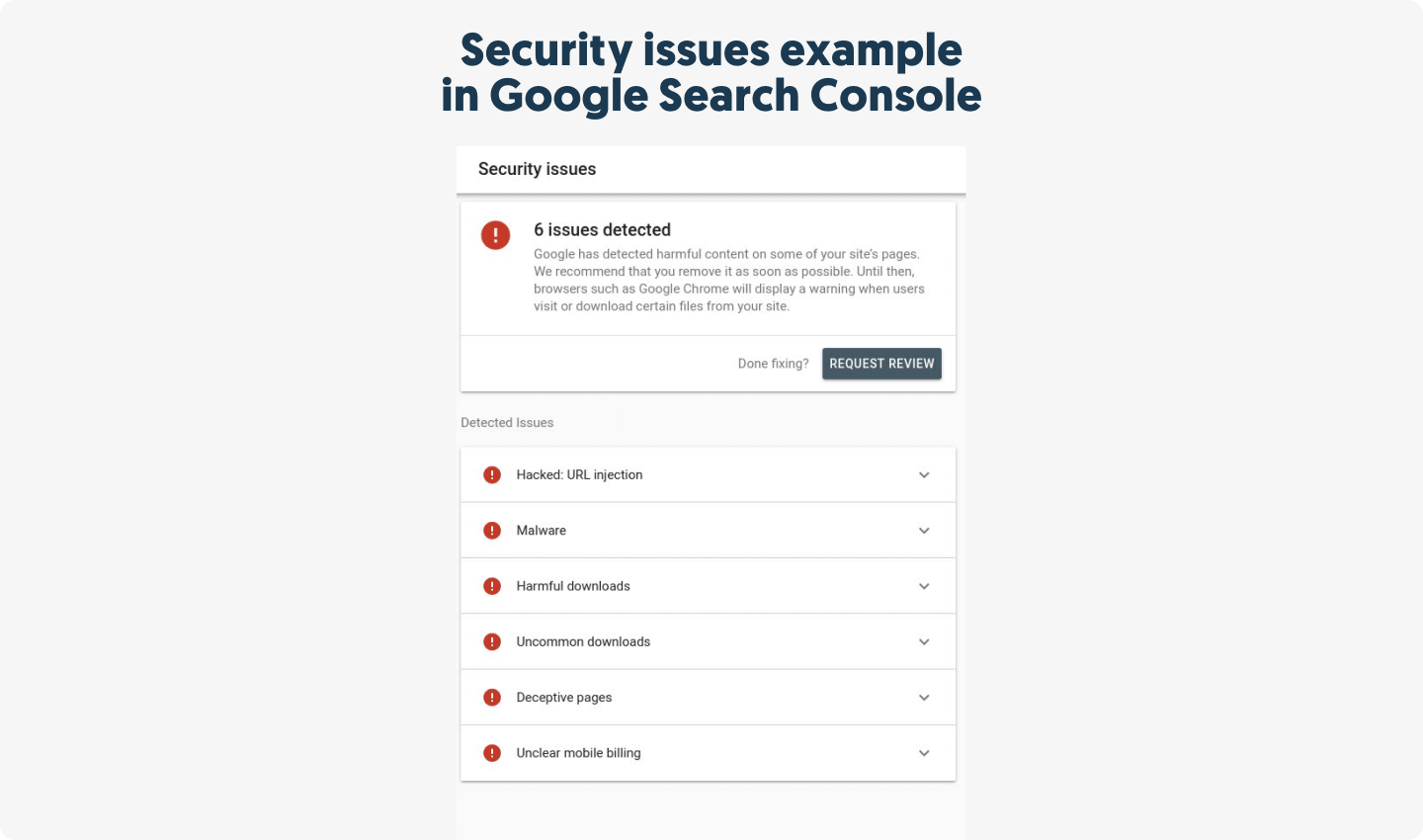
Final Thoughts
Technical SEO is essential to a successful online presence, as it ensures that search engines can crawl, index, and rank your website effectively. Following the best practices outlined in this guide, you can optimize your website’s technical aspects and provide a strong foundation for your overall SEO strategy.
Remember that technical SEO is an ongoing process; staying up-to-date with the latest trends and industry developments is crucial. Regularly auditing your website and addressing any issues that arise will help you maintain high search engine rankings and improve the user experience.
Every aspect of technical SEO plays a crucial role in your website’s success, from addressing crawling and indexing issues to enhancing website security. By implementing the tips and utilizing the tools mentioned in this guide, you’ll be well on your way to optimizing your website for search engines and achieving better visibility online.
If you ever feel overwhelmed by the complexities of technical SEO or need expert assistance, don’t hesitate to reach out to professionals who can help you navigate the intricacies of search engine optimization. With the right support, you can focus on growing your business while enjoying the benefits of a well-optimized website.

Frequently Asked Questions about Technical SEO
What is technical SEO, and how does it differ from on-page and off-page SEO?
Technical SEO refers to optimizing your website’s technical aspects, such as crawlability, indexability, and site performance, to improve search engine visibility. It differs from on-page SEO, which focuses on optimizing content and meta tags, and off-page SEO, which involves building backlinks and improving domain authority.
How can technical SEO improve my website’s ranking on search engine result pages?
Technical SEO ensures that search engines can crawl and index your website effectively. It also improves user experience by optimizing site speed, mobile-friendliness, and website security. These factors contribute to better search engine rankings and increased visibility.
What are the essential components of technical SEO, and how do they affect my website’s performance?
The essential components of technical SEO include crawlability, indexability, site speed, mobile-friendliness, website security, structured data, URL structure, internal linking, and website architecture. These components ensure that search engines can access and understand your website while providing a positive user experience, ultimately impacting your site’s performance in search results.
How can I conduct a technical SEO audit on my website, and what are the benefits of doing so?
A technical SEO audit involves analyzing your website’s technical aspects to identify issues that may hinder search engine visibility. It examines site speed, crawlability, indexability, mobile-friendliness, and more. The benefits of conducting an audit include improved search engine rankings, better user experience, and increased organic traffic.
What are websites’ most common technical SEO issues, and how can they be fixed?
Common technical SEO issues include slow site speed, crawlability, indexability problems, duplicate content, broken links, and mobile unfriendliness. These issues can be fixed by optimizing website performance, improving website structure, implementing canonical tags, fixing broken links, and adopting a mobile-first design approach.
How can website speed impact technical SEO, and how can I optimize it?
Website speed is a significant factor in technical SEO, as slow-loading websites can lead to poor user experience and lower search engine rankings. You can optimize your site speed by compressing images, minifying code, leveraging browser caching, and using a content delivery network (CDN).
How can I optimize my website’s structure and navigation for technical SEO?
Optimizing your website’s structure and navigation involves creating a clear hierarchy, using descriptive and concise navigation menus, implementing breadcrumb navigation, and creating an XML sitemap. These practices make it easier for search engines and users to understand and navigate your website.
What is schema markup, and how can it improve my website’s visibility in search results?
Schema markup is a structured data vocabulary that provides search engines with more information about your website’s content. By implementing schema markup, you can enhance your search result appearance with rich snippets, which can improve click-through rates and visibility in search results.
How can I ensure my website is mobile-friendly and optimized for technical SEO?
To ensure your website is mobile-friendly, adopt a responsive or mobile-first design, optimize site speed and performance for mobile devices, avoid intrusive interstitials, and ensure all content and features are accessible on mobile devices.
How do website security and HTTPS encryption impact technical SEO, and what are the best practices?
Website security and HTTPS encryption are essential for technical SEO, as they protect user data and foster trust. Implementing an SSL certificate and maintaining robust website security can improve your search engine rankings and user experience.
How can I optimize my website’s images and media for technical SEO purposes?
To optimize images and media for technical SEO, compress and resize images to reduce file size, use descriptive file names and alt tags, implement lazy loading, and use supported media formats for better device compatibility.
What is canonicalization, and how can it be used for technical SEO purposes?
Canonicalization is the process of specifying a preferred version of a web page when multiple versions exist. It can be used for technical SEO to prevent duplicate content issues, consolidate link equity, and ensure that search engines index the correct version of a page. Implementing a canonical tag on your website can help you achieve these goals.
How can I optimize my website’s XML sitemap and robots.txt file for technical SEO?
To optimize your XML sitemap, ensure it lists all essential pages, is regularly updated, and follows the correct XML syntax. For your robots.txt file, ensure it accurately specifies which pages should be crawled or ignored by search engines and is accessible at the root of your website.
What is hreflang, and how can it be used to optimize my website for multilingual SEO?
Hreflang is an HTML attribute that indicates a web page’s language and geographical targeting. It can be used to optimize your website for multilingual SEO by helping search engines understand which language versions of your content to display to users based on their location and language preferences.
What is crawl budget, and how can I optimize it for technical SEO purposes?
Crawl budget refers to the number of pages a search engine will crawl on your website within a given time. To optimize your crawl budget, ensure that critical pages are easily discoverable, limit the number of low-quality or duplicate pages, and improve site performance to reduce crawl time.
How do meta tags and descriptions impact technical SEO, and what are the best practices?
Meta tags and descriptions provide search engines with information about your webpage content. They impact technical SEO by influencing click-through rates and user engagement. Best practices include writing unique and descriptive meta tags and descriptions for each page and keeping them within the recommended character limits.
How can I optimize my website’s internal linking structure for technical SEO purposes?
Use descriptive anchor text to optimize your internal linking structure, create a clear website hierarchy, incorporate contextual links within your content, and avoid over-optimizing or excessive linking. This ensures that users and search engines can easily navigate and understand your website. If you’re using WordPress, you can use a plugin like Linkwhisper to help you generate internal links quickly.
What are the best practices for optimizing URL structure for technical SEO purposes?
Best practices for optimizing URL structure include using descriptive and concise URLs, incorporating relevant keywords, using hyphens to separate words, and maintaining a consistent URL structure across your website. This ensures that your URLs are easily readable and understood by search engines and users.
How can I use Google Search Console to monitor and improve my website’s technical SEO performance?
Google Search Console provides valuable insights into your website’s technical SEO performance. You can use it to monitor crawl errors, broken pages, sitemap status, and mobile usability issues. Additionally, it offers recommendations for improvements and allows you to submit updated sitemaps or request re-indexing of specific pages. Regularly monitoring and addressing issues identified in Google Search Console can help you maintain optimal technical SEO performance.